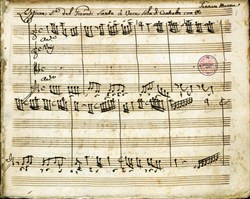The Lamentations
 The Lamentations of Jeremiah describe the pain caused by the siege and destruction of Jerusalem by Nebuchadnezzar, king of Babylon. The author is traditionally identified as the prophet Jeremiah, the central figure in the era when there was the destruction of Jerusalem, but this attribution is probably pseudepigraphic. It is, more realistically, poetic songs composed by different authors. However, in the Jewish tradition there are several witnesses who ascribe to Jeremiah these poems: the Talmud (B. Bathra), the Moèd Qatàn 26° Midràsh Rabà , the Targum, and also the various rabbinic commentaries of following years. Even the Greek version of the LXX confirms, putting the name of Jeremiah in the title of the Lamentations.
The Lamentations of Jeremiah describe the pain caused by the siege and destruction of Jerusalem by Nebuchadnezzar, king of Babylon. The author is traditionally identified as the prophet Jeremiah, the central figure in the era when there was the destruction of Jerusalem, but this attribution is probably pseudepigraphic. It is, more realistically, poetic songs composed by different authors. However, in the Jewish tradition there are several witnesses who ascribe to Jeremiah these poems: the Talmud (B. Bathra), the Moèd Qatàn 26° Midràsh Rabà , the Targum, and also the various rabbinic commentaries of following years. Even the Greek version of the LXX confirms, putting the name of Jeremiah in the title of the Lamentations.
The book is composed of five lyrical poems, divided into many chapters. The first, the second and fourth are acrostics (each line subsequently begins with one of the 22 letters of the Hebrew alphabet). The Lamentations are a prayer full of confidence in God, always merciful even in punishment, ready to intervene and help the city that has so severely punished. The first lamentation describes Jerusalem, desolate, compared to an abandoned woman who complains. The second lamentation exposes the cause of the massacre in Jerusalem: God, justly angry with its sins. The third lamentation expresses the heartfelt cry of Jerusalem who trusts in the mercy of God. The fourth lamentation presents a dramatic contrast between the present and the past of Jerusalem, enumerating the sins that have caused so many misfortunes. The fifth lamentation is the prayer of the elected people who exposes his misfortunes, and asks that the wrath of God will not be eternal.
During the eighteenth century, Naples represented a veritable nerve center for this genre, in particular for the presence of the Philippine Fathers, as evidenced by the myriad of lamentations preserved in the Girolamini‘s archive, among which those of Cristoforo Caresana, Gennaro Manna, Gaetano Veneziano and Francesco Feo stand out. The Ufficio delle tenebre provided in the ancient Christian tradition an apparatus of lights (fifteen candles which were gradually put off after the song of each lamentation and each psalm, until the total shutdown when the death of Christ is announced) and songs, among them we can remind: the Lamentations of Jeremiah, the Psalms and the Miserere. All Neapolitan compositions of that period were generally written for one or two voices and basso continuo.
